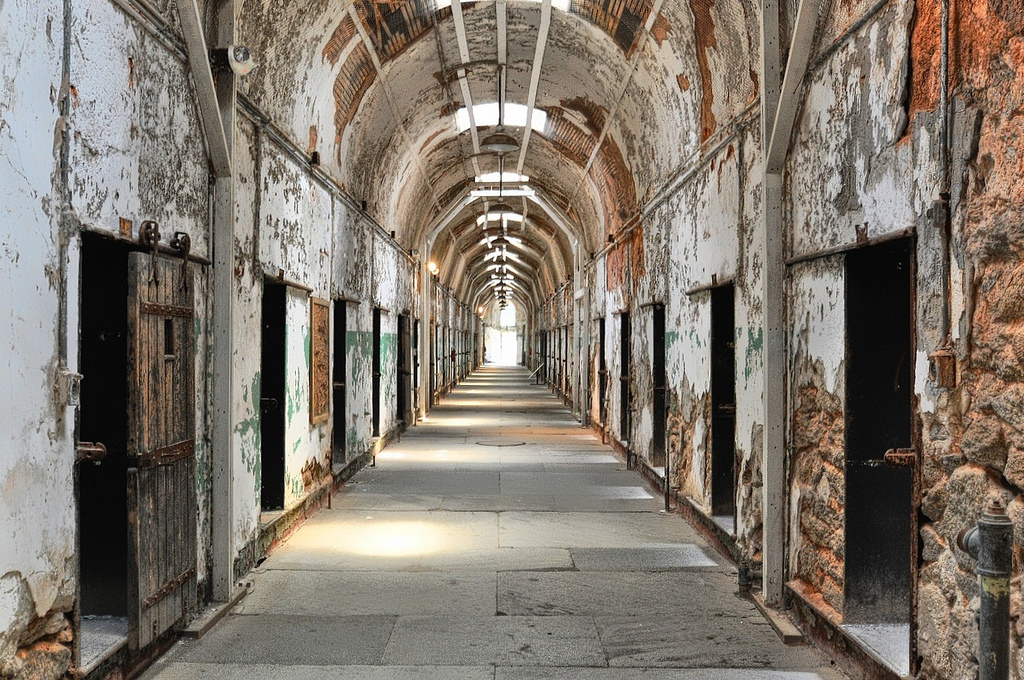
A cellblock in Philadelphia’s Eastern State Penitentiary. Photo © Forsaken Fotos, licensed Creative Commons Attribution.
A walk through Eastern State Penitentiary (N. 22nd St. and Fairmount Ave., 215/236-3300; daily 10am-5pm, last entry 4pm; $14 adult, $12 senior, $10 student and child (7-12), not recommended for children under 7) offers a glimpse into a world rarely seen by ordinary citizens. This eye-opening site forces visitors to imagine the lives of those behind bars and to consider the controversial history and ideals of the past and present criminal justice system. An alternative to the overcrowded prisons of the time, the Quaker-inspired goal of Eastern State was to reform criminals through strict isolation.When it opened in 1829, the penitentiary’s novel design and philosophy were considered radical experiments. Benjamin Franklin and Benjamin Rush were among the members of the first prison reform group in history—the Philadelphia Society for Alleviating the Miseries of Public Prisons—who supported the prison. Famed architect John Havilland won the design competition to build the prison, and one of his competitors, William Strickland, oversaw construction. The castle-like structure occupies 11 acres in what was then considered the outskirts of town, and today is the Fairmount neighborhood. It was the most expensive structure ever built in the country at the time.An alternative to the overcrowded prisons of the time, the Quaker-inspired goal of Eastern State was to reform criminals through strict isolation. It was founded on the belief that when left to their own devices without the influence of the outside world, prisoners would become “penitent,” or remorseful. Prisoners ate, worked, and lived in their cells, with an hour each day in a small private outdoor courtyard. When it was necessary to move through public spaces, hoods were placed over prisoners’ heads so they couldn’t see one another. The concept and the architecture became a model for prisons worldwide, and approximately 300 prisons on four continents were modeled on the innovative floor plan in which a central guard post is flanked with multiple sections extending from the center.
While the intentions of the founders were presumably good, the failings of the isolation system quickly became clear and the prison faced accusations of inhumane treatment of prisoners. The first investigation into the possibility of questionable practices took place in 1832. In 1842, Charles Dickens visited and said: “The system is rigid, strict, and hopeless solitary confinement, and I believe it, in its effects, to be cruel and wrong.” It wasn’t until 1913 that the confinement system was abandoned.
In 1970, the prison closed, and there was talk of tearing it down and using the space for commercial property. Fortunately, a task force set out to preserve what is now considered a National Historic Landmark. In 1994, Eastern State opened for daily tours. Visitors are required to sign a waiver stating that they are aware of the poor condition of the building before entering, but areas deemed unsafe are closed to the public.
Different tours take place throughout the day in which guides tell stories of prisoners, escapes, and more, but the well-made self-guided audio tour, “Voices of Eastern State,” is a great option. Actor Steve Buscemi’s voice, along with those of real prisoners and guards that served here, will guide you to more than 20 fascinating sites throughout the prison that reveal its rich history. Among the famous prisoners who did time here was Al Capone, who was apparently given royal treatment during his eight-month stay. A peek into his restored cell reveals a cushy apartment with antiques, rugs, oil paintings, and the sounds of a waltz that he frequently played on his radio.
If you happen to be in town and have a high tolerance for fear, the already-spooky site is transformed into the annual Terror Behind the Walls, a haunted house, every night in October.
Excerpted from the Third Edition of Moon Philadelphia.